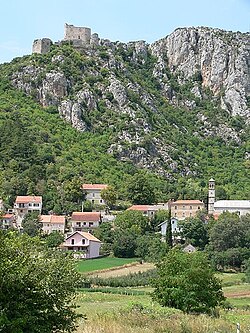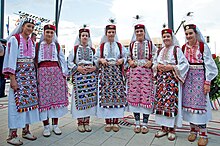This is an old revision of this page, as edited by Jon Kolbert (talk | contribs) at 17:43, 9 August 2017 (http->https). The present address (URL) is a permanent link to this revision, which may differ significantly from the current revision.
Revision as of 17:43, 9 August 2017 by Jon Kolbert (talk | contribs) (http->https)(diff) ← Previous revision | Latest revision (diff) | Newer revision → (diff) Town in Split-Dalmatia, Croatia| Vrlika | |
|---|---|
| Town | |
 Vrlika below Prozor Fortress Vrlika below Prozor Fortress | |
 | |
| Coordinates: 43°55′N 16°24′E / 43.917°N 16.400°E / 43.917; 16.400 | |
| Country | |
| County | |
| Government | |
| • Mayor | Jure Plazonić (HDZ) |
| Area | |
| • Total | 237.73 km (91.79 sq mi) |
| Population | |
| • Total | 2,177 |
| • Density | 9.2/km (24/sq mi) |
| Time zone | UTC+1 (CET) |
| • Summer (DST) | UTC+2 (CEST) |
| Postal code | 21236 Vrlika |
| Area code | 021 |
| Climate | Cfb |
| Website | Official site Template:Hr icon |
Vrlika is a small town and municipality in inland Split-Dalmatia County, Croatia. The closest large towns are Sinj, Knin, and Drniš. Vrlika was given the status of city in 1997.
Location
Vrlika is located in the Cetinska Krajina region in Split-Dalmatia County. It is 40 km northwest of the town of Sinj on the State route D1 between the towns of Sinj and Knin and on the regional route which connects Vrlika with Drniš.
History


The oldest evidence for human life in this region is from 30,000 BC. During the Bronze Age, between 1900-1600 BC, there was the so-called Cetina culture on the territory of Vrlika Municipality. Archaeologists have found ancient graves, a Bronze Age sword and other smaller stuff dating back to that period. These findings made it clear that in the past this land was densely populated. Prior to the arrival of the Romans, the Illyrian tribe of Dalmatae are said to have inhabited the region. After multiple wars, lasting for as long as 250 years, in the year 9 AD they were finally defeated and annexed by the Romans.
The history of the town begins in the 7th century when the Croats moved there and formed a village on the spring of the river Cetina, in a field below the mountain Dinara. In the 9th century probably during the time of Duke Branimir of Croatia, the old Croatian Catholic Church of Holy Salvation "Crkva Sv. Spasa" was built near Vrlika, then called Vrh Rike. Church was built by old Croatian Gostiha of Cetina "Cetinski župan Gastika" in memory of his mother and his sons.
Vrlika was first mentioned in written sources in 1069, as the seat of Cetin County (Cetinska županija) - the old Croatian county, which included the towns of: Glavaš, Prozor, Sinj, Trilj, Stolac, Gradac, Nutjak, Tugare and Poljic parish (Poljička župa). Of the five old Croatian counties (Imotska, Zminjska, Kliška i Dridska) that were located in the area of the current Split-Dalmatia County, Cetinska County was the largest.
In the year 1406 King Ladislaus of Naples gives Prozor Fortress, at that time Castrum Werhlychky as a center of Vrlička župa, to the Croatian noble Hrvoje Vukčić. During the medieval period Vrlika, along with the rest of the Balkans, experienced invasion and subsequent occupation by the Ottoman Empire. During the Ottoman rule the local population of Vrlika was forced to convert to Islam or leave. Many of the original settlers from Vrlika left for the island Olib in the Adriatic Sea off the Croatian coast.
In the late 17th century, the town was liberated from the Ottomans by the Republic of Venice as a result of the Morean War. Locally, the uprising against the Ottomans was led by Croatian priest Father Josip Bogić. During French rule (1805–1814), Vrlika became a municipality in the Šibenik district. Franz Joseph I of Austria visited Vrlika in 1875 and noted impressions in his diary.
The town was part of the Republic of Serbian Krajina on August 26, 1991. Soon after, the non-Serb population was expelled from the area. The Serbs had deliberately attacked medical facilities, including the centre for retarded children who had remained for several months without water, electricity or adequate medical supplies. After difficult negotiations, they had finally been transported to Split, but two of them had died of dehydration on the way. As part of Operation Storm, Vrlika was ethnically cleansed by the Croatian Army on August 6, 1995 where soon after, the remaining Serb population fled the area.
Demographics
According to 2011 census, the town of Vrlika has a population of 828, while the municipality has a population of 2,177.
Historic, cultural and natural heritage
- Prozor Fortress - fortress from early history above the town of Vrlika, expanded at the beginning of the 15th century
- Glavaš - Dinarić Fortress - fortress from the 15th century, near the town of Vrlika
- Church of Holy Salvation - the old Catholic church "Crkva Sv. Spasa" from 9th century near Vrlika
- Church of Our Lady of Rosary, Vrlika - the Catholic church from 19th century
- Dragović monastery - Orthodox monastery founded in 1395 southeast of Vrlika
- Vrlika national costume - folk costume of great ethnographic treasure in Croatia, best example is "Čuvari Kristova groba" during the Easter holidays
- Vrličko kolo - well-known silent folklore dance (kolo) from Vrlika
- Feast of Our Lady Ružarice - Catholic feast of "Gospe Ružarice", the city day of Vrlika
- Vrlička Česma - cultural site and park, genesis of famous Croatian opera "Ero sa onoga svijeta"
- Ero s onoga svijeta - a comic opera in three acts by Jakov Gotovac, with a libretto by Milan Begović based on a folk tale
- Cetina - spring of river Cetina, 7 km north from Vrlika
- Peruća Lake - a large artificial lake southeast of Vrlika
- Dinara - mountain located east of the town of Vrlika
- Svilaja - mountain located west of the town of Vrlika
- Čuvari Hristovog groba, Easter tradition
Local government
The current city council of Vrlika has fifteen seats:
- Croatian Democratic Union: 11 seats
- Croatian Party of Rights: 3 seats
- Croatian Social Liberal Party: 1 seats
Culture
Vrlika has a local branch of the Croatian cultural organization Matica hrvatska, as well as the Croatian Disabled Homeland War Veterans Association. Vrlika also has a folklore ensemble KUD "Milan Begović". From Vrlika originates the well-known folklore dance, Vrličko Kolo.
Economy
Throughout the history of Vrlika, major basic economic activities have been agriculture, livestock breeding, and trade. In modern times tourism, hospitality, and information technology are also substantial, with a focus on the principles of sustainable development.
Religion in Vrlika
- Church of Sveti Spas (9th century)
Built during the reign of Croatian duke Branimir in the 9th century, by župan Gostiha of Cetina, near Vrlika, then called Vrh Rike. This church is one of the most important in Croatia, as it is the only pre-schism church constructed with a bell tower that is still standing . 1,026 Old-Croatian ancient graves of great archaeological interest have been found in the vicinity of the church indicating that the culture of that time was under the influence of the Frankish Empire.
Main article: Church of Holy Salvation, Cetina- Monastery Dragović (1395)
The Dragović monastery was founded in 1395 while Vrlika was ruled by Croatian noble Hrvoje Vukčić from Bosnia. In 1480 the Ottoman Turks invaded the region, raided the monastery, and expelled its residents. For twenty full years it was abandoned until restored. Dragović monastery is situated on a hill downstream of the Cetina River not far from Vrlika. Its location was shifted several times due to wars and the construction of a dam on Cetina River
- Orthodox church (1618)
In 1618, the Orthodox church dedicated to Saint Nicholas was built by the Serb Orthodox inhabitants in and around Vrlika, where it still stands today.
- Roman Catholic Parish Church (1898)
Father Jure Bogić from Cetina established a Catholic parish of Annunciation of the Blessed Virgin Mary in 1688, and later Our Lady of the Rosary. The Roman Catholic parish church in Vrlika dedicated to the Nativity of the Virgin Mary (Croatian: Župna crkva Gospe Ružarice) was built from the year 1876 to 1898. The church was built on the site of a mosque, which was built on the foundations of an old Catholic church. This simple stone church dominates the Vrlika centre square. During the Second World War, the Catholic church in Vrlika sustained significant damage. In the front of the church stands a bronze bust dedicated to Filip Grabovac, who was born in the nearby village of Vinalić and died in Venice, Italy as a Croatian national hero. The exterior dimensions of the parish church are 27x10.30 metres. The Catholic Parish Church in Vrlika was badly damaged and desecrated during the recent Croatian War of Independence. The holy day of Gospe Ružarice, the protector of the Vrlika Catholic community, is celebrated annually during the first week of October.
Notable people
- Filip Grabovac (1698–1749) - Franciscan priest and writer
- Milan Begović (1876–1948) - writer
- Ante Kuduz - academic painter
- Petar Barišić - academic sculptor
Villages of the Vrlika municipality
Garjak, Ježević, Koljane, Kosore, Maovice, Otišić, Podosoje, Vinalić
References
- The FAME: Split and Dalmatia County - Cities
- Vrlika
- From the History of Omiš Krajina and Poljica
- http://public.carnet.hr/zuh/do1874/srv/srv_2.htm#1
- http://web.archive.org/web/20091026110447/http://geocities.com/kijevo01/sv_spasa.html Template:Hr icon
- ^ https://www.webcitation.org/query?url=http://www.geocities.com/TheTropics/4689/history.htm&date=2009-10-25+11:18:52
- ^ History of Visovac
- ^ "Vrlika Liberated". hrt.hr. Croatian Radiotelevision. Hina. 6 August 1995. Archived from the original on 4 June 2006.
- Hague: Investigation into suicide of Milan Babić in his cell
- ^ Angel, William David: (p.1033) The international law of youth rights: source documents and commentary Amazon.com, ISBN 0-7923-3321-7
- Population by age and sex, by Cities/Municipalities
- City government
- Vrlika
- Croatian Disabled Homeland War Veterans Association Vrlika
- KUD "Milan Begović" - Vrlika
- KUD Jedinstvo Split
- Srednji vijek
- Manastir Dragović
- Pravoslavne crkve u sjevernoj Dalmaciji
- Namjesništvo Splitsko
- grad Vrlika - RKT Župni ured
- Stanley Hochman (p.293) McGraw-Hill encyclopedia of world drama: an international ..., Svezak 4 Barnes&Noble.com ISBN 0-07-079169-4
External links
| Subdivisions of Split-Dalmatia County | ||
|---|---|---|
| Cities and towns |  | |
| Municipalities |
| |